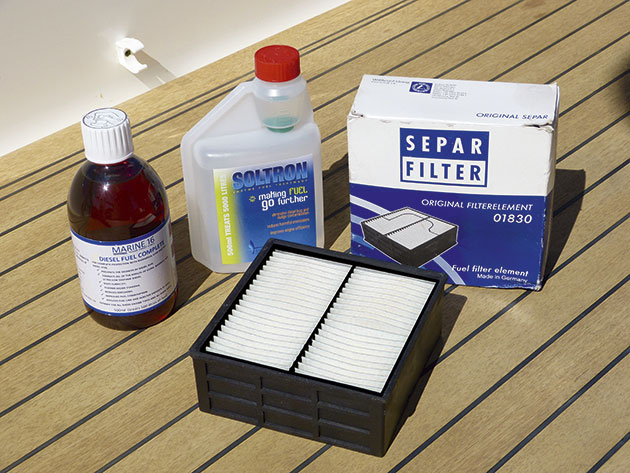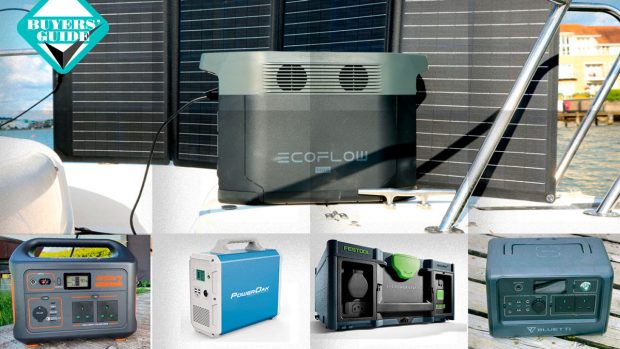For a reliable engine you need clean fuel and a clean tank. We test the Diesel Dipper, Marine 16’s answer to keeping it that way...
Fuel problems are the most common cause of breakdowns at sea. Some of the blame for this can be laid at the boat builder’s feet. Fuel tanks are often hard to access and many have no drain cock or inspection hatch so owners have to rely on their engines’ inline fuel filters to stop dirt and water getting into the injectors and combustion chamber.
However, these should be the last line of defence as they can quickly become overwhelmed if diesel bug or contaminated fuel gets into the system. Nor do they stop water and sludge accumulating at the bottom of the fuel tank, below the level of the fuel pick-up, caused by condensation and contaminated fuel.

The Diesel Dipper acts like a mini day tank which allows water and sludge to settle out before it reaches the engine filters. Over time it gradually cleans the bottom of the main tank
Marine 16 claims to have solved this problem with a product called the Diesel Dipper. Rather than drawing fuel from 20mm above the bottom of the tank as most fuel pick-ups do, the Dipper deliberately sucks out all the sludge and water that lurks at the very bottom of it and that causes rust to set in and provide the perfect breeding environment for diesel bug.
This contaminated fuel is then passed through a separator that removes any water and debris from the diesel and returns the clean fuel to the tank. Because diesel bug only thrives in the presence of water, if you get rid of the water you solve the bug issue too.
The heart of the unit is a low-power 12V pump that gently sucks the bottom 3-5% of the fuel from the bottom of your tanks at the rate of two litres per minute to prevent it emulsifying. This is passed through a series of baffles and swirl chambers that separates any water and sludge present and allows it to settle to the bottom of the unit for draining off later.
The clean fuel passes out of the top of the separator and, after a final filtration process, is returned to the main tank. Due to the efficiency of the separator, the final filter is a 40-micron stainless steel mesh that rarely needs cleaning and should never need replacing.
Article continues below…

VIDEO: How to… Prevent diesel bug
No owner wants plans to be cut short by diesel bug, Jon Mendez's video goes through how to prevent dreaded

Gevo biofuel: This zero-carbon diesel could be the key to a cleaner boating future
The reason most fuel pick-ups draw fuel from 20mm above the bottom of the tank is precisely to stop them picking up sludge. This is all well and good until fuel gets sloshed around the tank during a rough passage, stirring up sediment and blocking the engine’s fuel filters at precisely the moment you need them most. With the Dipper continually removing this sediment from the bottom of the tank (it runs whenever the engines do) there shouldn’t be any sludge left to get stirred up.
Because the Dipper is only designed to polish the bottom 3-5% of the tank rather than the full capacity, it can handle tanks of 10,000 litres or more. It is not intended as a panacea for filthy tanks that need steam cleaning or replacing, nor is it a replacement for the Racor style filters that sit in the fuel line as a last line of defence, but if you do see water and debris appearing in these, think how much worse the fuel must be below the pick-up pipe.
By keeping the tank clean it should also improve the life of any filters further down the line. The Dipper costs £785.40 and can be installed by a DIY-competent owner or by a professional at relatively low cost. To test how effective the Dipper is, Peter Caplen chose to fit and test one on his own boat to see how well it works…
Marine 16 Diesel Dipper tested
Ideally, the Dipper should be installed next to the fuel tank to make draining easy. On my boat there wasn’t sufficient space – the Dipper measures 37cm (H) x 15cm (W) x 18cm (D) – so I chose a spot on the engine bay bulkhead. The plumbing is straightforward, requiring either a fitting inserted into the drain valve on the bottom of the tank or a suction tube fed down from the top to suck the fuel into the Dipper, and a return line that needs to be teed into the engine’s existing fuel return line.
I used a standard compression fitting for the dip tube and engine fuel return tee but if you don’t have access to the inside of the tank, Marine 16 can supply a dip tube fitting that can be inserted into the top or side of the tank without needing access to the other side.
I bolted the Dipper onto mounting pads that allowed for the thickness of soundproofing on the bulkhead. The Dipper comes with straight hose connectors but I changed them for 90° elbows for a neater installation. I decided not to use the inline fuse and quick connectors as there was a spare breaker in the main box and it was sensible to use crimp terminals to keep everything uniform.
The Dipper is usually connected to the ignition switch so that the pump runs whenever the engine is switched on but I decided to add a separate switch next to the helm. This allows me to run the Dipper and clean the tank with the engine off, which I often do after refuelling.
I used the same Vetus fuel hose to take the diesel from the tank to the Dipper and back as I used for the engine fuel and return lines. Two jubilee clips on each connector ensures a reliable connection. Inside the tank the Dipper pick-up is cut at an angle and positioned tight against the bottom of the tank, well below the level of the engine and Eberspächer fuel pick-ups. I also added a T-valve into the return so that I can drain the tank using the Dipper if needed.
In use, the Dipper needs no attention other than occasional cleaning of the separator and filter – just switch off the Dipper, open the by-pass valve at the top of the unit to avoid air locks, then open the drain valve and collect the run-off. To clean the filter, unscrew the case, remove the element and wash in clean diesel.
So does it work? To find out, I bravely added a glass of water to the 30 gallons of diesel in my brand new tank! After running the Dipper for a suitable length of time, I drained off the separator and much to my relief collected the same amount of water at the bottom of the jar.
MBY rating: 5/5
Value: 5/5
First published in the December 2020 issue of Motor Boat & Yachting.
Note: We may earn a commission when you buy through links on our site, at no extra cost to you. This doesn’t affect our editorial independence.

Diesel Dipper uses filters and swirl chambers to separate water and solids from fuel

Dip tube inserted through top of fuel tank

Dipper bolted to engine bay bulkhead

Angled dip tube sits below level of fuel pick-up

Pouring water in to test how effective it is

Draining contaminated fuel from Dipper tap










